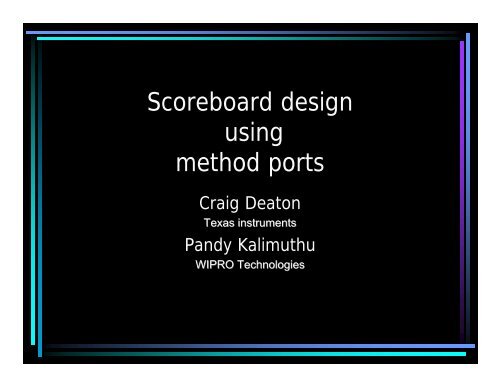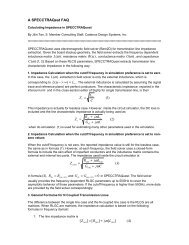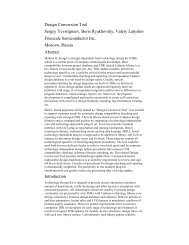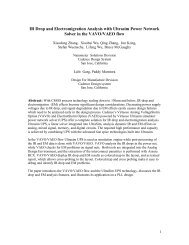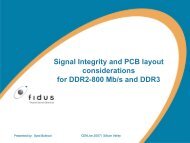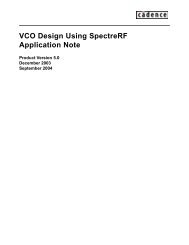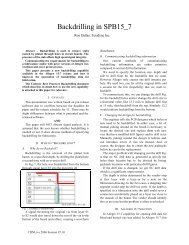Scoreboard Design Using Method Ports
Scoreboard Design Using Method Ports
Scoreboard Design Using Method Ports
Create successful ePaper yourself
Turn your PDF publications into a flip-book with our unique Google optimized e-Paper software.
<strong>Scoreboard</strong> design<br />
using<br />
method ports<br />
Craig Deaton<br />
Texas instruments<br />
Pandy Kalimuthu<br />
WIPRO Technologies
Introduction<br />
• <strong>Method</strong> ports provide a mechanism for calling<br />
methods or TCMs defined in other ‘e’ uints or written<br />
in other foreign languages<br />
• <strong>Method</strong> ports provide a mechanism for implementing<br />
transaction-level interfaces between specman and<br />
higher level language<br />
• Here, we have used the method port to construct a<br />
scoreboard and demonstrated how powerful they are<br />
in terms of exchanging information across various<br />
eVCs
How does it work<br />
• <strong>Method</strong> ports essentially allow methods to be treated like data<br />
types.<br />
• <strong>Method</strong> ports can be pushed onto lists<br />
• Here, the key point is a list of method port at the source of the<br />
data extraction, and ports to be pushed onto it where the data<br />
is to be used<br />
• This allows other eVCs/Units to get copies of the extracted data<br />
by adding requestor method port to source list
A Sub-system level verification<br />
environment
Sub-System level <strong>Scoreboard</strong><br />
connection using <strong>Method</strong> ports
Sub-System level to System level
Advantages<br />
• Easy to connect module level scoreboard to the<br />
system level scoreboard<br />
• Easy to enable/disable various scoreboards.<br />
• Easy to exchange the data from one monitor of eVCs<br />
to other eVCs<br />
• Avoid duplication of data extractor monitor by<br />
populating information of one eVCs to other eVCs<br />
seamlessly
How to implement (monitor side)<br />
• Define a method port type that matches the prototype of the<br />
associated method<br />
– method_type sys_sb_message_t (message : trans_s);<br />
– Here, trans_s is a common “struct” that should be used across<br />
many eVCs. So , it’s better to define the struct at the global define<br />
file<br />
• Create list of out method ports at the data extractor unit (the<br />
place where data extraction happens)<br />
– out_trans_l : list of out method_port of sys_sb_message_t;
How to implement (monitor cont.)<br />
• Create a method to collect data by calling each method port in<br />
the list<br />
– Send_msg(message : trans_s) is {<br />
for each in out_trans_l {it$(message); };<br />
};<br />
• Call this method whenever the data extractor has something to<br />
report<br />
– data_extract_tcm() is @clk {<br />
….<br />
send_msg(cap_data_s);<br />
};
How to implement (scoreboard side)<br />
In the scoreboard unit(place where data needs to be exchanged):<br />
• specify output method port instance<br />
– collect_trans : out method_port of sys_sb_message_t is<br />
instance;<br />
• input method port instance<br />
– collect_trans_in : in method_port of sys_sb_message_t is<br />
instance;<br />
• Bind input to output<br />
– keep bind(collect_trans, collect_trans_in);
How to implement (scoreboard cont.)<br />
• Put call to scoreboard in “input” portion of method port<br />
– collect_trans_in(info : trans_s) is {<br />
call_sb(info);<br />
};
How to implement (integration)<br />
• Connect the scoreboard to the monitor by pushing the “input”<br />
portion of the method port onto the list in the data extractor<br />
– run() is also { mon.out_trans_l.add(sb.collect_trans);};
CASE STUDY
CASE STUDY continues…
CASE STUDY continues…<br />
• Co-processor sub-system contains three co-processors and<br />
memories used by the three co-processors<br />
• System DMA is used to load data into the memories and<br />
transfer processed data to other locations in the system<br />
• All co-processors connected to memories via bridge<br />
• System DMA is also connected to memories via bridge<br />
• All co-processors are verified in the module level with their<br />
respective eVCs<br />
• Each of the module eVCs contains data extractor, scoreboard<br />
and coverage monitor
CASE STUDY continues…<br />
• In the module level, the verification environment contains only module<br />
level eVC and various BFMs<br />
• In the module eVC, Co-processor scoreboard unit and coverage<br />
monitor unit gets data from data extractor unit via method ports<br />
• <strong>Method</strong> ports at scoreboard unit and coverage monitor unit are added<br />
to the list of method ports at data extractor unit and gets the data<br />
whenever data available<br />
• <strong>Scoreboard</strong> at the module level is mainly intended to verify the<br />
property of the module extensively<br />
• In the sub-system level, the main interest is verifying data path across<br />
various masters to/from slaves<br />
• In this case, verifying data path between System DMA to memories<br />
and Co-processors to memories
CASE STUDY continues…<br />
• The sub-system level verification environment is constructed<br />
with co-processors module level eVCs, memory port eVCs and<br />
System DMA port eVCs<br />
• A sub-system level scoreboard was constructed by adding the<br />
method ports of the sub-system SB to the list of method ports<br />
at various monitors<br />
• For example, in the case of scoreboard across co-processor-I<br />
and memories, the scoreboard was easily constructed by adding<br />
the method port at the sub-system level SB to both list of the<br />
method ports at monitor of co-processor eVC and monitor of the<br />
memory eVC<br />
• The sub-system level SB gets data from both monitors during<br />
write and read
CASE STUDY continues…<br />
• When write is initiated from the co-processor, the sub-system level SB<br />
gets data from co-processor eVC’s monitor and SB stores the data<br />
• When write is seen at the memory port, the sub-system level SB gets<br />
data from memory port eVCs and compares that data against previous<br />
stored data(received from co-processor monitor)<br />
• The same way data comparison occurs during read also<br />
• One important point to be noted is during sub-system level verification,<br />
the module level verification environment also present and active<br />
• Any system level application test carried out at the sub-system level in<br />
a way verifies module level properties using module level scoreboards<br />
and sub-system level properties using system level scoreboards
Summary<br />
• <strong>Method</strong> ports are a convenient way to<br />
implement interfaces to data extractors<br />
• <strong>Using</strong> method ports to connect<br />
scoreboards to data extractors has<br />
several advantages:<br />
– Easier implementation<br />
– Lower risk of mistakes<br />
– Easier integration into system & subsystem
Summary (cont.)<br />
A concise example of this approach can<br />
be found in the “<strong>Method</strong> <strong>Ports</strong>” section<br />
of the “E Reference Manual”.<br />
For Specman 4.3.2, the example can be<br />
found in section 4.1.1.2.<br />
This example was created and submitted<br />
by the authors of this paper.


